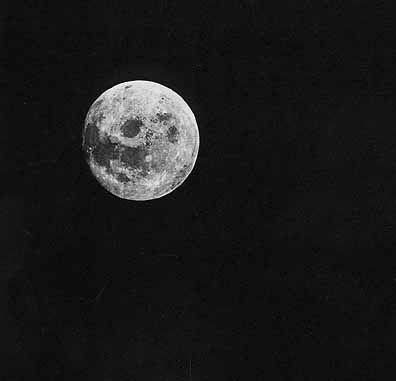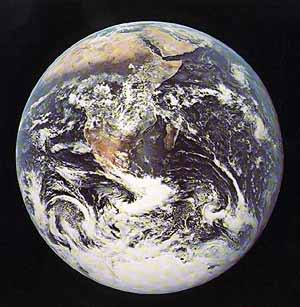
Epilog
|
[254] |
 |
FIGURE 248.-A view of the full lunar disk taken by the Apollo 11 astronauts upon completion of their exploration mission, on the way back to Earth. In this view we see the dark lunar maria that dot the brighter highlands which form most of the lunar surface. From the samples, photographs, and other data gathered by the Apollo lunar exploration missions, we have learned a great deal about the Moon.
In a nutshell, the Moon appears to have formed about 4.6 billion years ago, along with the rest of the solar system. Accretional energy generated by the collisional impacts may have melted the upper 100 to 300 km, allowing differentiation that resulted in a lighter (anorthositic gabbroic) crust and a denser (pyroxene rich) interior. A few remaining large bodies collided with the solid crust, the last of them about 4.0 billion years ago, forming the circular basins. After that, between about 3.9 and 3.2 billion years ago, a period of volcanism occurred. For 700 million years, basaltic lavas poured from the lunar interior to cover nearly 15 percent of its surface. In the last 3 billion years or so, the only tangible modifications of the lunar surface were due to meteoroid impacts; there may have been some volcanic eruptions, but they were not globally significant. The only satellite of our dynamic Earth (facing page) is a silent Moon.-F.E. B.
|
[255] |
 |
|
|
FIGURE 249.-This magnificent view of the Earth was taken during the last manned journey to the Moon. For the first time, on Apollo 17, the Antarctic icecap was visible to the astronauts. The view also encompasses much of the South Atlantic Ocean; virtually all of the Indian Ocean, Africa, the Arabian Peninsula; part of Iran and India; and, on the horizon, Indonesia and the western edge of Australia.
The history of the Moon summarized on the preceding page may provide significant information to increase our understanding of the Earth, because the Earth and the Moon were most probably formed at the same time (4.6 billion years ago). Because of the dynamism of the Earth and the many changes that have affected its surface since its creation, the oldest rocks that we find on it are about 3.5 billion years old (in Greenland and South Africa). This means that the first 1 billion years of Earth's history have been obliterated. Therefore, the Moon may be used as a window to view the early history of our own Earth.-F.E. B.